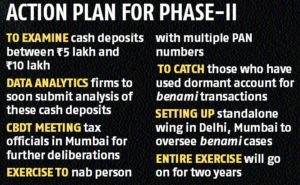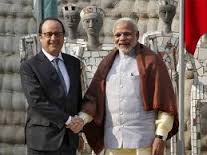 Following a poor response to the Pradhan Mantri Garib Kalyan Yojana (PMGKY), an income declaration scheme, the Income Tax (I-T) department is set to launch another drive to catch hold of tax evaders who could have deposited large sums during the demonetisation drive.
Following a poor response to the Pradhan Mantri Garib Kalyan Yojana (PMGKY), an income declaration scheme, the Income Tax (I-T) department is set to launch another drive to catch hold of tax evaders who could have deposited large sums during the demonetisation drive.
While the first phase of the so-called Operation Clean Money scrutinised cash deposits of over Rs.10 lakh, the second phase will examine deposits between Rs 5 lakh and Rs 10 lakh.
A data analytics firm has already started the analysis of such cash deposits made during demonetisation drive. The information will soon be sent to the Central Board of Direct Taxes (CBDT), which will decide further course of action.
Tax officials said that the action plan for the second phase has been prepared by the I-T department. A high-level meeting of senior CBDT officials will take place in Mumbai on Friday to make further deliberations.
This will be the first such meetings, where tax officials from across the country will brainstorm, since the PMGKY scheme ended on March 31.
Sources said statement of financial transaction (SFTs) submitted by banks after demonetisation is being sent for data analysis.
Under the SFTs, banks and post offices have been mandated to submit all information on cash deposits in current accounts of Rs 12.5 lakh and above during demonetisation. The tax department is said to have received SFTs from over 200 public, private and cooperative banks for 50 days after demonetisation before January 31.
“The data tally will be done by matching the cash deposits with the tax profile of the persons. It could be a massive exercise as numbers of depositors under this range would be very high,” said an I-T official.
The second phase data is crucial for examination of cash deposits by the tax department, as it will be more accurate and upgraded.
“So far we have been getting information on only very high-value transactions from the Financial Intelligence Unit. With the SFT, we will be able to get data on all deposits in the set limit,” an official explained.
In the first phase of the operation covering seven million PAN (permanent account number) card holders depositing high-denomination currency notes of Rs 500 and Rs 1,000, the department has identified 1.8 million persons who had made suspicious deposits over Rs 10 lakh during the 50-day demonetisation period. Their deposits aggregated to Rs 4.17 lakh crore.
Unlike the first phase, the operation will focus on identifying multiple accounts and PAN numbers, which could be of a single person and on those who have used dormant accounts for benami transactions.
“We observed several cases where persons deposited their unaccounted old currency in someone else’s bank account. Such cases will be probed under the newly enforced Benami Transactions Act,” said the official cited above.
Under the Act, violators could be prosecuted and sentenced to rigorous jail term of up to seven years.
The CBDT is believed to be setting up a separate department, which will only deal with benami transactions. “Considering the importance of the Act, the tax department is likely to start this as a pilot project from Delhi and Mumbai,” said another tax official with direct knowledge.
Sources said that the tax department could completely ignore deposits less than Rs 5 lakh in the second phase. Also, data mining and the entire exercise would go on for two years. However, the biggest concerns with the information would be that a large number of people who deposited the cash during the demonetisation drive are not registered with the tax portal.






